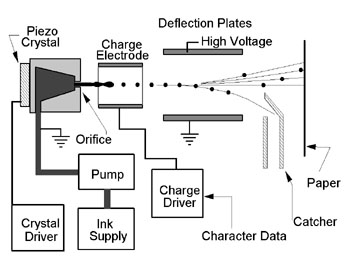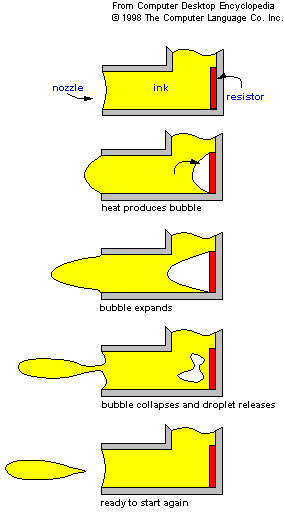Inkjet Printing Technique
Inkjet printing is a liquid deposition technique, by which the droplets of the ink were ejected with the same volume and printed on the substrate. It is a low cost, material-conserving, non-contact, additive patterning, and maskless approach with the scalability to large area manufacturing. According to the formation of the uniform drops, printers are classified into two categories: continuous inkjet printer and drop-on-demand (DOD) inkjet printer.
For continuous inkjet printer, the ink ejected by the high pressure is broken into uniform droplets by electromechanical devices, at the same time the droplets are charged and directed to the designed place in the present of the deflecting electrode. Figure 1 shows the schematic of the continuous inkjet printer [1]. This type of inkjet printer possesses high-frequency drop generation; however, the cost is also high as its great space requirement and the complicated ink system. It is best suited for graphic arts and industrial applications.

Fig. 1 The schematic of continuous inkjet printer
For DOD inkjet printers, the drops were generated by the volume changes of the channel caused by the applied voltage on the piezoelectric materials of the channel wall. Fig. 2 shows the actuator principle of ejecting uniform drops from the ink [2]. At the beginning the voltage is applied on one channel and as the piezoelectric effect, the channel is enlarged and filled with the ink; then the voltage will applied to the neighbor channel, which will is enlarged and at the same time the first channel will shrink and release a drop of ink. Thus by applying voltage on channels, the ink can be ejected as a form of drop and printed on substrate as the pattern designed.

Fig. 2 Actuator operation principal of the printhead
There is another type of DOD printer, bubble jet, which is thermal driven. The stream pocket is produced in the channel by the heating element, as shown in Fig. 3[3]. As the applied voltage, the resistor heat up and produces bubble which forces the ink to jet out to form drop. The schematic of DOD inkjet printer is shown in Fig. 4, in which the droplets are produced by applying voltage according to the desired.

Fig. 3 Thermal driven principle

Fig. 4 DOD inkjet printing system.
The DOD printer system is less complex than the continuous printers, and thus the cost will be lower. It is the commercial available inkjet printer today.
2. How it works?
Droplets formation
Firstly droplets with the same volume need to be produced. For the continuous printers, the ink is pushed out from the orifice by the pressure and separated into the drops by the charge electrode according to the character data (Fig. 1). For the DOD printer, however, they eject droplet by applying voltage, which will change the volume of the channel (piezo-electrically driven) or produce bubble in the channel (thermal driven) to jet the ink out.
Image generation
Then the ink droplets print on the substrate. For the continuous printers, the droplets are loaded with certain amount of charges, and distracted from their straight trajectory under the deflecting electrode to land at desired places. For the DOD printer, by moving the substrate, the droplets jet to the right place as they only produced when it is demanded (Fig. 4).
3. Quality control factors
The drop volume, drop speed, and wettability of the substrate, et.al, are important factors influence the quality of the printout. We will use the piezo-electrically driven DOD printers to achieve the inkjet printing with good quality. Firstly, the print quality related to the printhead of the inkjet printer.
Printhead
Crosstalk: the mutual influencing of the channels through common walls. This will affect the volume and the speed of the drops and thus influence the print quality.
Angle deviation: the geometry of the nozzles can change the direction of the jet drops, and thus lead to the deviations from the desired place.
Satellites: the drops always have tails, and they are split into small droplets and landed to the substrate later than the main drops. The visible of the satellites depend on the distance of the substrate and the nozzle.
Beside, we also need to consider about the ink supply (which affect the drop volume if it is too low, and even suck the nozzles and blocks the channel), difficult pattern (too fast for the channel to fade away from the former blast waves), and the initial state problems (make sure the channel is at the fixed state for every blast waves). We should also take the changes of the temperature into account as the viscosity and the velocity is affected. Thus we need to test the fill and fire procedures for each printhead when we use it.
Ink
There are also some important factors from the ink. The viscosity, defined as the inner friction of the liquid, affects the drop speed greatly. The velocity of the sound (How to understand this?), the density and the surface tension, et.al, are also influence the printout as the filling of the printhead and the ink supply are affected.
Notice that the ink should compatible with the printhead. This means the ink can not deposit on the printhead, and the printhead material must not swell. The simple test for the compatibility of the ink and the printhead, is to investigate the weigh changes of the pieces from the printhead after dipping them in the ink for a certain period.
4. Curving mechanism
There are some curving mechanisms for the printout on the substrate to improve the adhesive. Ultraviolet curing is the mechanism for epoxy adhesives. At certain wavelength the photo initiators are incited and combined the epoxy rings to form cationic concatenation prolongation. Thermal curing is another mechanism to form chemical bonding for the special adhesive.
5. Applications
The inkjet printing technology can be used in many fields, just name a few [4]: thin film transistors, light emitting devices, solar cells, memory and magnetic applications, contacts and conductive structures, sensors and detectors, biological and pharmaceutical applications, inkjet patterning, fabrication of electronic circuits, controlled deposition of nanoparticles, sample preparations of polymeric coatings, rapid prototyping and so on.
References
[1] http://www.microfab.com/about/papers/chibook/chi_book.html
[2] http://www.microfab.com/about/papers/ist95/ist95.html
[3] http://www.yourdictionary.com/computer/inkjet-printer
[4] Madhusudan Singh, Hanna M. Haverinen, Parul Dhagat and Ghassan E.Jabbour. Inkjet printing-process and its applications.




Comments